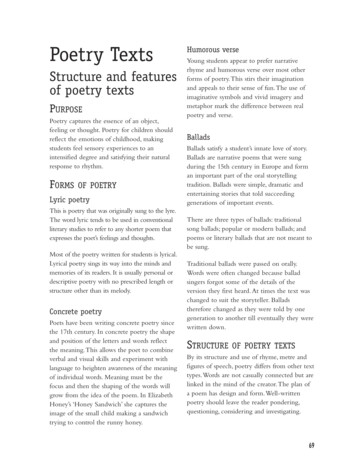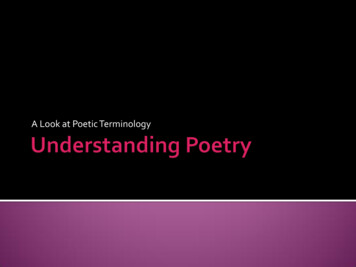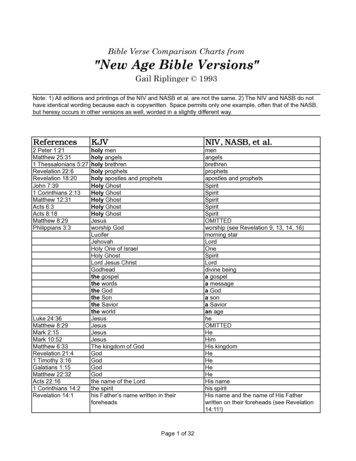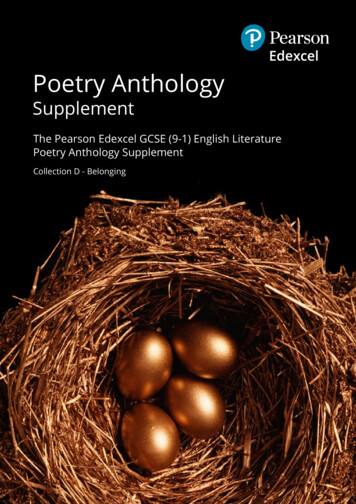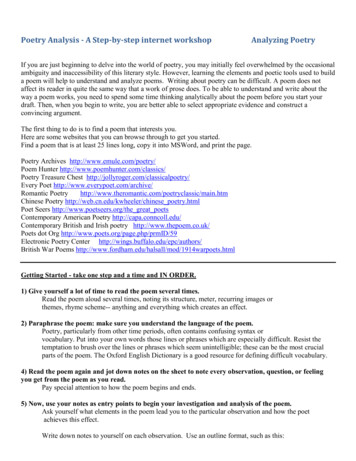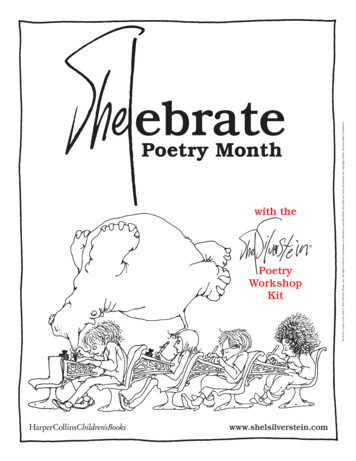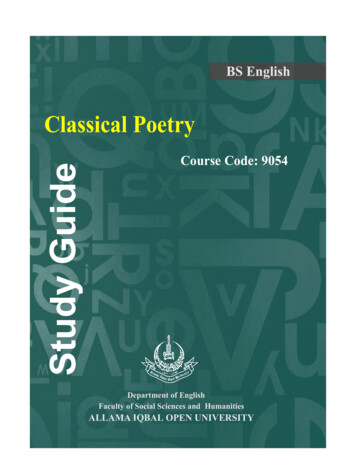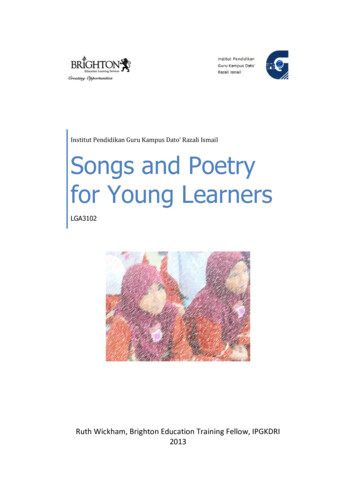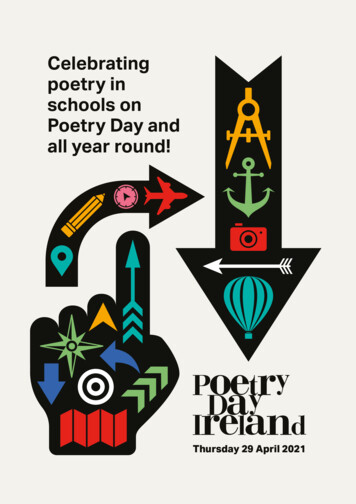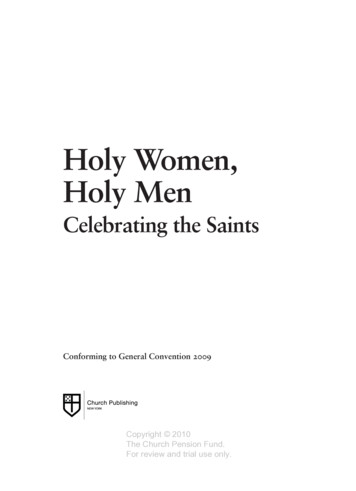
Transcription
Unseen PoetryPreparationAnthologyThe Pearson Edexcel AS and A level English LiteratureUnseen Poetry Preparation Anthologycan be used to prepare for Component 3 of your assessment
PearsonEdexcel GCEin English LiteratureApproaching Contemporary Unseen Poetry:An Anthology of poems and resourcesFor use with:GCE English Literature A level (9ET0) Component 3
Published by Pearson Education Limited, a company incorporated in England and Wales, having itsregistered office at Edinburgh Gate, Harlow, Essex, CM20 2JE. Registered company number: 872828Edexcel is a registered trade mark of Edexcel Limited Pearson Education Limited 2014First published 201417 16 15 1410 9 8 7 6 5 4 3 2 1British Library Cataloguing in Publication DataA catalogue record for this book is available from the British LibraryISBN 9781446913505Copyright noticeAll rights reserved. No part of this publication may be reproduced in any form or by any means(including photocopying or storing it in any medium by electronic means and whether or nottransiently or incidentally to some other use of this publication) without the written permissionof the copyright owner, except in accordance with the provisions of the Copyright, Designs andPatents Act 1988 or under the terms of a licence issued by the Copyright Licensing Agency, SaffronHouse, 6–10 Kirby Street, London, EC1N 8TS (www.cla.co.uk). Applications for the copyrightowner’s written permission should be addressed to the publisher.See page 65 for acknowledgements.
Contents1Introduction42How to approach an Unseen Poem: four perspectives6345672A Professor Peter Barry – Aberystwyth University, English Department2B Gary Snapper – English Teacher, Cheney School, Oxford / Editor, NationalAssociation for the Teaching of English2C Maurice Riordan – Editor, The Poetry Review, The Poetry Society2D Patience Agbabi – Poet and PerformerContemporary Poets’ Voices16Sample Unseen Poems34Unseen Responses: Reviewing your Answers41Student Essays51Glossary64Poems with discussion points and further reading:3A Jacob Sam-La Rose, ‘Faith’with a chosen poem by Alexandra Teague3B Jen Hadfield, ‘Daed-traa’with a chosen poem by Tom Leonard3C Patience Agbabi, ‘Martina’with a chosen poem by Kona Macphee3D Helen Dunmore, ‘The Duration’with a chosen poem by Rudyard Kipling3E Esther Morgan, ‘Sand’with a chosen poem by Percy Bysshe Shelley3F George Szirtes, ‘My father carries me across a field’with chosen poems by Dante/Ciaran Carson and Derek MahonIndividual post-2000 poems with examination-style essay questions:Leontia Flynn, ‘My Father’s Language’Helen Mort, ‘Thinspiration Shots’Michael Donaghy, ‘Resolution’Dannie Abse, ‘Scent’Don Paterson, ‘The Wreck’Julia Copus, ‘Raymond, at 60’Simon Armitage, ‘Birthday’Supporting notes on the Unseen poems:5A Leontia Flynn5B Helen Mort5C Michael Donaghy5D Dannie Abse5E Don Paterson5F Julia Copus5G Simon Armitage: A critical essay by Ruth PadelExample 1Example 2Example 3Example 4Example 5Example 6
1 IntroductionSomething of a ‘secondary school canon’ of modern poetry has built up over the years;we hope that this collection will extend the pool of great poets studied in today’sschools and colleges. We believe that the move to study post-2000 texts, that havebeen written in the lifetime of all those taking A level English Literature, will offerstudents an exciting opportunity – to see how today’s poets treat issues and concernsthat are sometimes universal and sometimes specific to our twenty-first century lives.It ensures that some of what you study really does look at the here and now, at poetswho reflect on the world you inhabit.The collection begins with four essays by specialists whose professional life is closelylinked with English literature and poetry – an academic, a teacher, an editor and a poet.They offer you some ‘ways in’ to approaching unseen poems and some strategies forhoning your skills.Who better to teach you about contemporary poetry than the poets themselves? Mostof this anthology is written by six of the best in contemporary poetry. We have triedto create the next best experience to live poetry readings; in this collection, the poetsthemselves introduce their work to you through one of their poems, and then choosea second poem they think will help your A Level study of contemporary literature. Wehope you get a sense of their voice, interests and particular styles and are drawn to readsome of the further reading suggestions they make, to widen your knowledge of theliterature of your time and what underpins it. Their questions will help you learn aboutthe choices writers make using both form and language to convey meaning. These canbe used during class discussion time, so that you familiarise yourself with these poetsand their methods. You can then apply the knowledge and skills you have learnt to thesecond half of this anthology where you are provided with a sample of Practice Unseens.These, together with our linked sample student essays and examiner comments, willsupport your work on improving your Unseen Poetry responses.We hope in your preparation for the A level paper 3 exam that you will also spend timereading and understanding some poetry from the canon. For A level students this willoccur, in part, in your Prescribed Poetry study for Component 3B. In this collection, somepoets have directed you to read poems from that canon that offer a meaningful link totheir own chosen poems. Making links between poems, selecting appropriate pointsof comparison and drawing connections across them will help prepare you for yourexamination tasks. The conductor Simone Young once said about music that ‘traditionis the handing on of the flame, not the worshipping of the ashes’. The same can besaid about literature and in many ways this is the intention of this collection. It is rightthat today’s students study the literature that is being produced in their own time. Thepublished anthology of contemporary poetry that you study for this component, andthe unseen poems that you meet in the examination, will be written or published post2000. But we cannot study contemporary poetry in isolation. We must also understandthe strong and deep connections that today’s writing has with the literature that hascome before it. In some contemporary poems we see a continuation of forms andtraditions from the literary giants that have preceded them. In others, we see deliberaterule-breaking and manipulation of such traditions.4
Section 1 IntroductionMany of the poets featured in this anthology are performing live around the country right now. Theycan be seen up close and personal, reading in small bars, cafes and other venues around the UK. Wehope that you will take the opportunity to hear some of them live and be inspired by them. For thoseof us at the exam board who have had our own A level Literature teaching groups, some of our bestteaching moments have been seeing sixth formers transfixed by a performance from a contemporarypoet. Some of you might be inspired to take part in the annual T. S. Eliot Poetry Prize Shadowingscheme which will enrich your reading of contemporary poetry.T. S. Eliot said that there are different stages of becoming a good reader. You begin intuitively, enjoyingsome poems, discarding others. After a while you start organising your experience of reading. Youfind you’re reading each poem in the light of others and understanding them all more precisely, evenones you’ve read already. You see more in them and enjoy more*. We hope that the signposts andjourneys in this collection will be a milestone in your reading of poetry and that you find some newpoets that inspire and lead you forward.PearsonEsther MenonKaty LewisConsulting PoetEsther Morgan*‘The Poem and the Journey’, 60 poems for the Journey of Life, R. Padel, Vintage, 20075
2 How to approach an Unseen Poem: four perspectivesRead the four perspectives on ways of approaching unseen poems. You may wish to annotatethe essays and compile your own checklist of the valuable advice that you find here.2A Approaching an unseen poem: a close (and distant) readingProfessor Peter Barry, Aberystwyth UniversityA Soft-edged Reed of LightThat was the house where you asked me to remainon the eve of my planned departure. Do you remember?The house remembers it – the deal tablewith the late September sun stretched on its back.As long as you like, you said, and the chairs, the clock,the diamond leaded lights in the pine-clad alcoveof that 1960s breakfast-room were our witnesses.I had only meant to stay for a weekbut you reached out a hand, the soft white cuff of your shirtopen at the wrist, and out in the yard,the walls of the house considered themselvesin the murk of the lily-pond, and it was done.Done. Whatever gods had bent to us then to whisper,Here is your remedy – take it – here, your future,either they lied or we misheard.How changed we are now, how superiorafter the end of it – the unborn children,the mornings that came with a soft-edged reed of lightover and over, the empty rooms we woke to.And yet if that same dark-haired boywere to lean towards me now, with one shy handbathed in September sun, as if to say,All things are possible – then why not this?I’d take it still, praying it might be so.by Julia Copus, from The World’s Two Smallest Humans (2012)Just lookingTo make a close reading of a poem you need to read it several times. But don’t rush. Start byjust looking at it. This one is divided into two twelve-line stanzas, with a gap in between. Soperhaps it presents a topic from two different viewpoints, or describes an event which has twodistinct stages. We would expect some shift or development from one part to the next, and justlooking alerts us to the need to describe the nature of this shift. We notice, too, that the twoparts hinge on the word ‘done’, which ends the first and begins the second. ‘Done’ can refer tosomething which has been done, or something which two parties have agreed to do, in whichcase they may shake hands and say ‘Done!’ Both senses are relevant. But don’t assume thatevery aspect of a poem’s form is directly related to content. Constant straining to demonstratea tight interlock between the two often results in far-fetched readings. So there is nothingsignificant here in the verses having twelve lines each. It’s not a cryptic reference to the twelvedays of Christmas (though Christmas features in the last line, as we’ll see).6
Section 2 How to approach an Unseen Poem: four perspectivesSlow readingHaving spent a few minutes ‘just looking’, you can now start reading the poem. My advice is asbefore – don’t rush it. In fact, the opposite – try to become a slow reader. Also, don’t read thelines, or the stanzas – read the sentences. To work out the sense of a poem, you must ignorethe line endings and the stanza breaks and read the sentences, because lines of poetry are notintended as stand-alone units of sense. So when reading the opening (‘That was the housewhere you asked me to remain’), don’t stop at the end of the line – go on till you reach the fullstop that ends the sentence in the next line – ‘on the eve of my planned departure.’ The openingline is ‘run-on’, meaning that its sense runs on across the line ending. When you get to the fullstop you have the gist of the situation presented in the poem. If you lose the overall sense atany point, go back to the beginning of the sentence in which the loss of sense occurred (or,better still, the one before that) and read through again from there. One slow reading of thisconcentrated kind is worth five or six rapid skim reads.But the situation of a poem isn’t usually set out from its beginning, for poems often startas if suddenly, with a train of thought already well under way. Thus, the opening ‘That wasthe house’ indicates that the speaker has been thinking (or talking) about this house forsome time. The poem goes straight to a pointed question addressed to the other personinvolved – ‘Do you remember?’ But is the question actually asked, or only formed mentally?It is difficult to be certain, but if a conversation is taking place, it seems to be of the intimatekind that would only happen if a couple were alone. Yet ‘we’ readers can hear it, even thoughwe are not the ‘you’ who is the primary addressee – we are like ‘over-hearers’, or covertaddressees. This is a frequent occurrence in lyric poetry (poetry which seems to conveythe intimate, private feelings of a speaker) – John Stuart Mill, in his essay ‘What is Poetry?’(1833), described poetry as ‘overheard speech’, noting that poets write as if unaware of ourpresence, as if self-communing, as a person might when writing a diary, or communicatingonly with a significant other.Close and distant readingSo now we can put forward a ‘distant reading’ (that is, an overview) of the situation presentedin the poem, which would go something like this: in the first stanza the speaker recalls themoment in a particular house which instigated a relationship that in the end led nowhere. Inthe second she says that if she could return to that moment, she would take the offered handagain, and make the same bargain, in spite of knowing that it never could be their ‘remedy’, ortheir ‘future’, while at the same time praying that – somehow – it might be.So the ‘distant reading’ briefly summarises the situation depicted in the poem (though itdoesn’t paraphrase the poem, of course), and it is an essential part (or partner) of the ‘closereading’. It is the necessary frame within which all the details commented on in the closereading cohere and make sense. For the close reading, try not to snip out from the poemisolated words, phrases or lines to use as evidence. Instead, quote a significant block of textwhich seems crucial, and then home in on it. I will do that with the last five lines, whichcrystallise the effect of the poem, with their touching (pun intended) profession of faith inwhat cannot actually be believed:And yet if that same dark-haired boywere to lean towards me now, with one shy handbathed in September sun, as if to say,All things are possible – then why not this?I’d take it still, praying it might be so.7
Section 2 How to approach an Unseen Poem: four perspectivesI give these lines as a ‘displayed quotation’, rather than as lines run on in my own text withline-endings indicated by an oblique stroke. I do so to foreground the poem as a poem, and tohighlight my view that these lines are crucial. Notice that what is quoted is a complete sentence,making sense in itself even when isolated from the rest. Writing it out in full is another way ofslowing down, making me notice things about these lines that I might otherwise have missed.For instance, the order of the phrases seems to have a delaying effect, postponing the eventualarrival of the decisive and quietly defiant statement ‘I’d take it still’. Thus, between the ‘one shyhand’ and ‘I’d take it still’ there are two intervening lines, and the effect is to emphasise thesignificance of the handclasp by seeming to make the moment happen in slow motion. Theorder of the phrases manipulates emphasis onto the key declaration and puts it in the strongestposition, right at the end of the poem.I notice, too, that in both stanzas the line about the hand reaching out (the fifth-to-last linein both) is longer than the lines around it, as if reaching beyond the margin-line of the stanzainto a void which is both unknowable and already known. It might be possible to identifyother symmetries and effects of this kind in the poem. But don’t overdo this kind of thing.Good poems don’t always have formal elements of this ‘mimetic’ kind (that is, elements thatseem to ‘mime’ or ‘enact’ their meaning).Tone and traditionThe close reading should also comment on tone or diction (meaning word choice and style). ‘ASoft-edged Reed of Light’ is fairly formal in tone, rather than chatty or colloquial. For instance,it mentions ‘the house where you asked me to remain’ (rather than ‘stay’, as we would probablysay in relaxed conversation) ‘on the eve of my planned departure’ (rather than ‘the night before Iwas due to go’). So the tone seems related to that of the more formal poetic styles of an earliercentury. There are other echoes: addressing a house directly reminds me of Tennyson’s poem‘Dark house, by which once more I stand’, about being outside the house of his dead friendArthur Hallam as dawn breaks (Poem 28 of In Memoriam). Further, the ending of ‘A Soft-edgedReed of Light’ directly echoes Thomas Hardy’s ‘The Oxen’, which is about the old countrylegend that animals in the fields kneel for Christ’s birth at midnight on Christmas Eve. The lasttwo of the four quatrains (that is, four-line stanzas) read:So fair a fancy few would weaveIn these years! Yet, I feel,If someone said on Christmas Eve,‘Come; see the oxen kneel,‘In the lonely barton by yonder coombOur childhood used to know,’I should go with him in the gloom,Hoping it might be so.The delaying effect is seen here too, as two lines are inserted between ‘Come; see the oxenkneel’ and ‘I should go with him’, exactly as two lines in ‘A Soft-edged Reed of Light’ separatethe ‘shy hand’ from ‘I’d take it still’. It is worth noting, finally, that Copus changes Hardy’s‘Hoping it might be so’ to ‘praying it might be so’. Which is stronger, or better? I don’t know, butsometimes the questions we ask are more important than their answers, and no close readingcan explain everything about a really good poem. If a close reading, by some chance, evermanaged to do that, we would have nothing to bring us back to the poem again.8
Section 2 How to approach an Unseen Poem: four perspectivesFurther reading Reading Poetry, Peter Barry, Manchester University Press, 2013: the first five chapters are onMeaning, Imagery, Diction, Metre and Form; Chapter 6 is on ‘Close and Distant Reading’;Chapter 8 is on ‘Text and Context’. How to Study Modern Poetry, Tony Curtis, Macmillan, 1990: Chapter 2 (‘The Making of aPoem’) is on his own ‘The Death of Richard Beattie-Seaman’, then four chapters on the1940s/50s, 60s, 70s and 80s. How Poets Work, Tony Curtis (ed.), Seren, 1996: an edited collection of chapters by modernpoets, each on the evolution of one of their own poems (including Dannie Abse on acricket poem and Simon Armitage on one about football). 52 Ways of Looking at a Poem, Ruth Padel, Chatto, 2002: 52 chapters, each printing amodern poem, followed by a 2- to 3-page reading of it.2B Approaching an unseen poem – a teacher’s perspectiveGary Snapper, English Teacher, Cheney School, Oxford / Editor, NationalAssociation for the Teaching of EnglishWhat makes a teacher happy when they read a response to an unseen poem? I’ve read hundredsof such essays over the last 25 years, and I’ve thought hard not only about what makes a goodresponse, but also how to help my classes to produce them. I’ll try here to distil my thoughtsin this short space – just as you will have to do when you try to organise your thoughts aboutan unseen poem in your AS or A level exam.First, and perhaps most important, when I read the unseen response essay I hope to get asense that the writer is someone who understands how poetry works and what it is for. Firstand foremost that means someone who understands that poems are not intended to be studiedin classrooms or written about in exams, but rather are written to be read for pleasure: the aestheticpleasure a poem’s creativity provides – both through the ideas and meanings it evokes and,equally importantly, in the way it is crafted by the poet – its shape, sound, form, structure,tone, style, imagery, and so on, and the way it plays with and makes patterns from words.It may seem ironic for me to say, in an article about writing about poems in exams, that oneof the things I’m looking for is a sense that poems are not intended to be written about in exams– but it’s an important point. To really understand and analyse poetry, you have to be able tosee poems as works of art, lovingly crafted by poets to tell stories, make arguments, reflecton experiences and evoke feelings, using language in a very particular, often playful, way.They are not like crossword puzzles or maths problems that need to be solved. Each poem is acarefully shaped whole employing a variety of poetic techniques to create an object of beauty– a work of art – and a thought-provoking experience. Your job, in an unseen commentary, isto explore this fragile object without losing a sense of its purpose and wholeness, its real lifeoutside the classroom and the exam hall.Why might anyone want you to write about poems in exams, when that’s not what they arefor? To understand that, you need to reconcile yourself to the difference between reading andstudying poetry: they are not the same thing, although of course they are strongly connected.In ‘the real world’, people read poetry for pleasure in their leisure time, or turn to poems forsolace or joy at times of difficulty or celebration, or use them to bold effect in performancesand advertisements – and so on. When you study poetry in an A level literature course, you aresetting out on the path to becoming an expert in a specialist academic field – learning aboutthe history and methods of a powerful and influential form of communication, to analyse thesubtleties of skilled thought and language, and to develop your own subtleties of response. Inyour response to the unseen poem, you have the opportunity to show that you can apply theknowledge you’ve gained in class about how to think and write about poetry.9
Section 2 How to approach an Unseen Poem: four perspectivesReading a poem, in various ways, is of course part of studying it, and when you approach anunseen poem your first readings of it are crucial: it’s the nearest you’ll get to the experience ofreading the poem for pleasure in ‘the real world’. It’s at this point that you need to let the impactof the poem speak to you. What kind of poem is it? What does it sound like? What does it feellike? What shape or form does it have? What feelings or thoughts does it evoke? What imagesor words immediately stand out? Imagine you are looking at a painting in an art gallery andlistening to a piece of music at the same time. What sounds and images grab your attention?Then there’s the question of what the poem is about. Again, this should strike you as part ofyour first impressions of the poem: a general impression of the theme of the poem, or its overallmessage (if there is one). And don’t forget that the title of the poem is usually significant too!You’ll probably need to read the poem two or three times before you begin to be clear aboutthese things – and this is before you even start to think in detail what it means. But don’t losethese first impressions of the poem. A poem is more than just the meaning of its words: it’s alsoabout its aesthetic impact – and a good response will convey this.Many of my students want to go straight to what the poem means and what techniques are usedin the poem, skipping the question of what the poem is like, and what impact it has. Once theybegin writing, some are too keen to launch in at this point, instead of establishing the impactof the poem and its overall narrative or meaning to anchor the rest of their analytical answerfor their reader. So when I introduce poems to my classes, I try to read them aloud in a waythat emphasises the sounds and structures of the poem as well as its meanings, or I ask themto prepare readings which do the same. I try to impress on them how important it is to hearthe poem in your head when you read it. Many poems use sound effects – rhyme, assonance,consonance and alliteration – often, but not always, creating some kind of onomatopoeia– which contribute to the pleasure of the poem, and may also reflect the meanings in thepoem. But such sound effects are only part of the way a poem sounds: the silences, breaks andpauses in a poem are part of its effect, as are the poem’s overall pace, rhythm, tone, mood andatmosphere.Once you’ve thought about the impact of the poem, you can start to reflect in more detailon the content of the poem, and the way it’s structured: what the poem actually means, whatthe argument or narrative of the poem is, how the various parts of the poem connect, andhow the poem develops from beginning to end. It’s vital to remember here that meaning isconstructed by the reader as a response to what the poet has written. In many poems, meaningsare deliberately ambiguous: the poet wants the reader to engage actively in deciding what thepoem might be about. Such ambiguity is again intended to be part of the pleasure and interestof much poetry. In these cases, a good response will tentatively suggest what a poet might mean,or offer more than one possible interpretation. So, for example, an answer that establishes‘the poet describes a relationship between two people, possibly one that is about to end, andexplores both its sensual and destructive qualities’, before going on to explore relevant sectionsof the text, is more carefully crafted than an answer which asserts ‘the poet describes a failedrelationship which has ended and has had a destructive effect on him’.Finally, you can begin to think in detail about the form and language of the poem: the techniqueswhich the poet has used to convey its images and ideas. There’s no mystery here. I teach mystudents about the ‘bag of tricks’ that poets carry about – the various verse forms they canchoose from; the way they use stanza, rhyme, metre, end-stopping and enjambement; the waythey choose and combine words and sentences to create a particular tone, mood, atmosphereor style; the way they use literal and figurative imagery (description, metaphor, simile) andrhetorical devices.10
Section 2 How to approach an Unseen Poem: four perspectivesAfter identifying these techniques, I know that the real work my students have to do is to learnhow to write subtly and sensitively about the effects these techniques have in the context of thewhole poem – how they contribute to the meaning of the poem and the experience of readingit. The candidate who writes ‘The poem is constructed in four stanzas of five lines each’, with nomore about how that structure reflects on the poem’s content, might be well advised to removethis comment completely. A response which comments ‘the progress of the four stanzas chartsthe progress of the speaker’s movement from emotional pain to acceptance’, and goes on toanalyse how the poem’s language reflects this, is building a stronger analytical essay.Now that you’ve thought about all these things, you’re ready to start writing. The introductionto your essay is where you can show that you have thought carefully about the experience ofthe poem as a whole work of art – briefly indicating what it’s about, what kind of poem it is,what its impact is, what kind of language it uses, what kind of message or meaning it mighthave. By the end of your introduction, the examiner will be happy because you’ve alreadyshown that you have a pretty good idea of how poetry works and what it is for – and there’sa good chance that they can sit back and enjoy whilst you talk them through your detailedanalysis of the content, language and form of the poem.Remember that the unseen commentary is only one way of writing about poetry. It’s a typeof exercise known as ‘literary appreciation’ which is designed to cultivate your knowledgeof poetry as a literary craft and your sensitivity to the ways writers use language and readersrespond to it. It’s important to be aware that there are other critical ways of writing aboutpoetry which are more concerned with evaluating the cultural significance and value of poets’work, and of poetry in general. Once you’ve got the basics of poetry sorted, you’ll be ready forthat next step!Further readingIf you’re going to read lots of poetry, it makes sense to start by reading poems that have beenidentified as really good, interesting or worth reading by the people who put together poetryanthologies. Some of these anthologies are designed specifically to introduce readers to a rangeof really great poems of many different sorts by many different writers. Poem for the Day, Nicholas Albery and Peter Ratcliffe (eds.), Chatto and Windus, 1994: thisis one of the best anthologies, which gives you one poem to read each day. The Nation’s Favourite Poems, Griff Rhys Jones (ed.), BBC Books, 1996: another goodanthology, which focuses on some of the best-known and best-loved poems. Penguin’s Poems for Life, Laura Barber (ed.), Penguin Classics, 2007: you could also try thisanthology, which organises poems around different stages of life, from birth to death.Also try finding the poetry anthology shelf in your local bookshop. You’ll find a huge range ofanthologies on offer – from collections of poems about love, war, Scotland, sport and so on, tocollections of comic verse and ‘Poems That Make Grown Men Cry’.11
Section 2 How to approach an Unseen Poem: four perspectives2C Approaching an unseen poem – a poetry editor’s perspectiveMaurice Riordan, Poet/Editor of The Poetry Review‘A poem should not mean/but be’, so says an old poem about poems.A poem isn’t a series of statements or observations or arguments. It isn’t mere prose. It’s morealive than that. Indeed, Ted Hughes believed his poems about animals continued his habit asa child – the rather cruel habit – of capturing little creatures and keeping them in his pockets.Poems have the fascination, if not quite of living beings, then of language at its most alive.They come to us with a voice that’s still carrying the pulse and warmth of the body.But those printed words are inert, a useless lump, until they are re-activated by a reader andbrought to life again in the mind.Look at the poem first. Some poems sit comfortably on the page. They are tidy and wellbehaved, as Shakespeare’s sonnets are. Others sprawl all over it, re
published anthology of contemporary poetry that you study for this component, and the unseen poems that you meet in the examination, will be written or published post 2000. But we cannot study contemporary poetry in isolation. We must also understand the strong and deep connections that today's writing has with the literature that has
